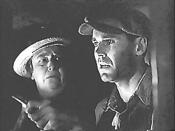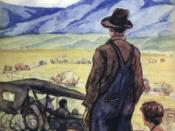The Grapes of Wrath is a novel chronicling the hardships endured by migrant families moving west to find a better life. In order to achieve the affect he wanted, John Steinbeck used an array of symbolism, from transcendentalism, to foreshadowing, to biblical allusions.
First, the main transcendentalist symbolism present in The Grapes of Wrath is in the character of Jim Casy. Casy is an ex-preacher who renounced his calling because of a sinful act he committed with a young girl after a religious meeting. "'?An' some I'd baptize to bring 'em to. An' then?you know what I'd do? I'd take one of them girls out in the grass, an' I'd lay with her. Done it ever' time.' (29)" When Tom Joad, who was going home from prison, meets Casy along the way, Casy explains his idea of the "human sperit". "'I figgered, 'Why do we got to hang it on God or Jesus? Maybe,' I figgered, 'maybe it's all men an' all women we love, maybe that's the Holy Sperit ? the human sperit?the whole shebang.
Maybe all men got one big soul ever'body's a part of.' (32-33)" Before Tom meets him, Casy had been wandering in the wilderness in an attempt to find himself. "'I ain't seen you in a long time,' [Tom] said. 'Nobody seen me,' said the preacher. 'I went off alone an' I sat and figured. The sperit's strong in my, on'y it ain't the same. I ain't so sure of a lot of things.' (28)" This is a blatant example of transcendentalism.
Second, the elements of foreshadowing in The Grapes of Wrath are very prevalent. The major uses of foreshadowing that Steinbeck encompasses are the interchapters.



Comment
This essay is too short. Your essay has too much quotations, and less ideas. You need to write more about what you think, and about the thesis statement.
6 out of 6 people found this comment useful.